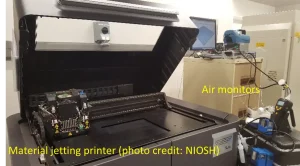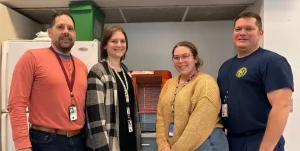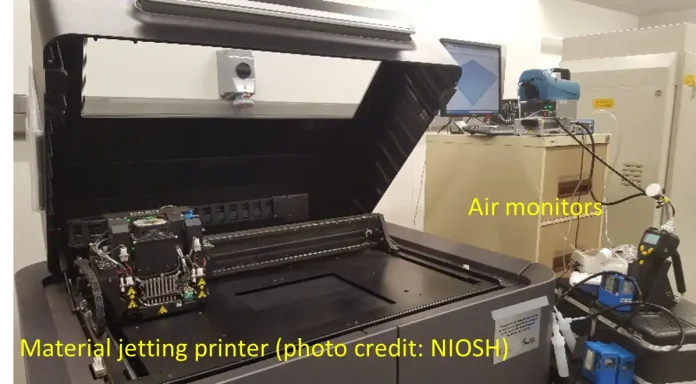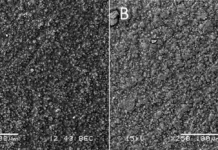By Aleksandr B. Stefaniak, Lauren N. Bowers, Elizabeth D. Arnold and Stephen B. Martin, Jr., NIOSH Respiratory Health Division

The repeated flashes of light and the steady rise of an intricate shape from a pool of resin inside a vat photopolymerization printer.
The whirring of a print head carriage moving back and forth and the gradual appearance of an object on the build platform of a material jetting printer.
These processes can be exciting and captivating to watch; though as shapes are being revealed before our eyes, there is more happening than just layers of ultraviolet (UV)-curable resin being deposited one-upon-another. Invisible to sight, and sometimes without odor, very small particles and gases are being released into the air around the printer.

At the National Institute for Occupational Safety and Health (NIOSH), researchers are working to understand how these particles and gases are released, their composition and if they present an inhalation hazard to a printer-operator or bystander so that more science-based guidance can be developed on safely working with UV-curable resins. While it has been recognized for many years that skin contact with UV-curable resins can cause irritation or even an allergic reaction in some people1, the risk from breathing in resin emissions is less clear.
To understand how emissions are released, a NIOSH research group first divided potential factors into two categories: 1) properties of the feedstock resin (color, composition, etc.) and 2) characteristics of the printer itself (design, size, type of technology, etc.). Next, the influence of each of these factors systematically was evaluated by monitoring airborne emissions, either in a laboratory test chamber or in a workplace.
Results-to-date show that the size of particles released during vat photopolymerization printing can be very small – approximately 15 to 45 nanometers (billionths of a meter)2, or as much as 5,300 times smaller than the width of a human hair. When inhaled, particles this small, often called “ultrafine particles,” can reach the deepest regions of the lung where oxygen is exchanged for carbon dioxide. The release of ultrafine particles during printing with UV-curable resins is notable because it can be difficult for the body to remove these small particles from the deep lung. Additionally, studies of other types of ultrafine particles, such as air pollution, indicate the potential for adverse effects to the lung and cardiovascular system. Studies have not yet been done to determine if small particles released during printing with UV-curable resins present a health hazard, though breathing in ultrafine particles released during fused filament fabrication 3D printing with thermoplastics can cause a rapid short-term rise in blood pressure (hypertension) in mice3.
Several organic gases are released during printing with UV-curable resins4. Not all gases released from resins will present a health risk, though some (e.g., 2-hydroxypropyl methacrylate, which is an immune sensitizer) can induce development of life-long allergy and, consequently, are important to characterize and assess risk.
While research is ongoing, opportunities for exposure can be reduced by wearing nitrile or neoprene gloves whenever skin contact with resin is possible and conducting tasks that involve resin (pre-printing, printing, post-printing) in a well-ventilated area.
NIOSH is a non-regulatory government agency whose mission is to develop new knowledge in the field of occupational safety and health and to transfer that knowledge into practice. For more information, visit
www.cdc.gov/niosh.
References
- Chang, T.Y., L.J. Lee, J.D. Wang, R.H. Shie, and C.C. Chan, Occupational risk assessment on allergic contact dermatitis in a resin model making process. Journal of Occupational Health 46(2): 148-152 (2004).
- Stefaniak, A.B., L.N. Bowers, A.K. Knepp, T.P. Luxton, D.M. Peloquin, E.J. Baumann et al., Particle and vapor emissions from vat polymerization desktop-scale 3-dimensional printers. Journal of Occupational and Environmental Hygiene 16(8): 519-531 (2019).
- Stefaniak, A.B., R.F. LeBouf, M.G. Duling, J. Yi, A.B. Abukabda, C.R. McBride et al., Inhalation exposure to three-dimensional printer emissions stimulates acute hypertension and microvascular dysfunction. Toxicology and Applied Pharmacology 335: 1-5 (2017).
- Bowers, L.N., A.B. Stefaniak, A.K. Knepp, R.F. LeBouf, S.B. Martin, A.C. Ranpara et al., Potential for Exposure to Particles and Gases throughout Vat Photopolymerization Additive Manufacturing Processes. Buildings 12(8)(2022).






